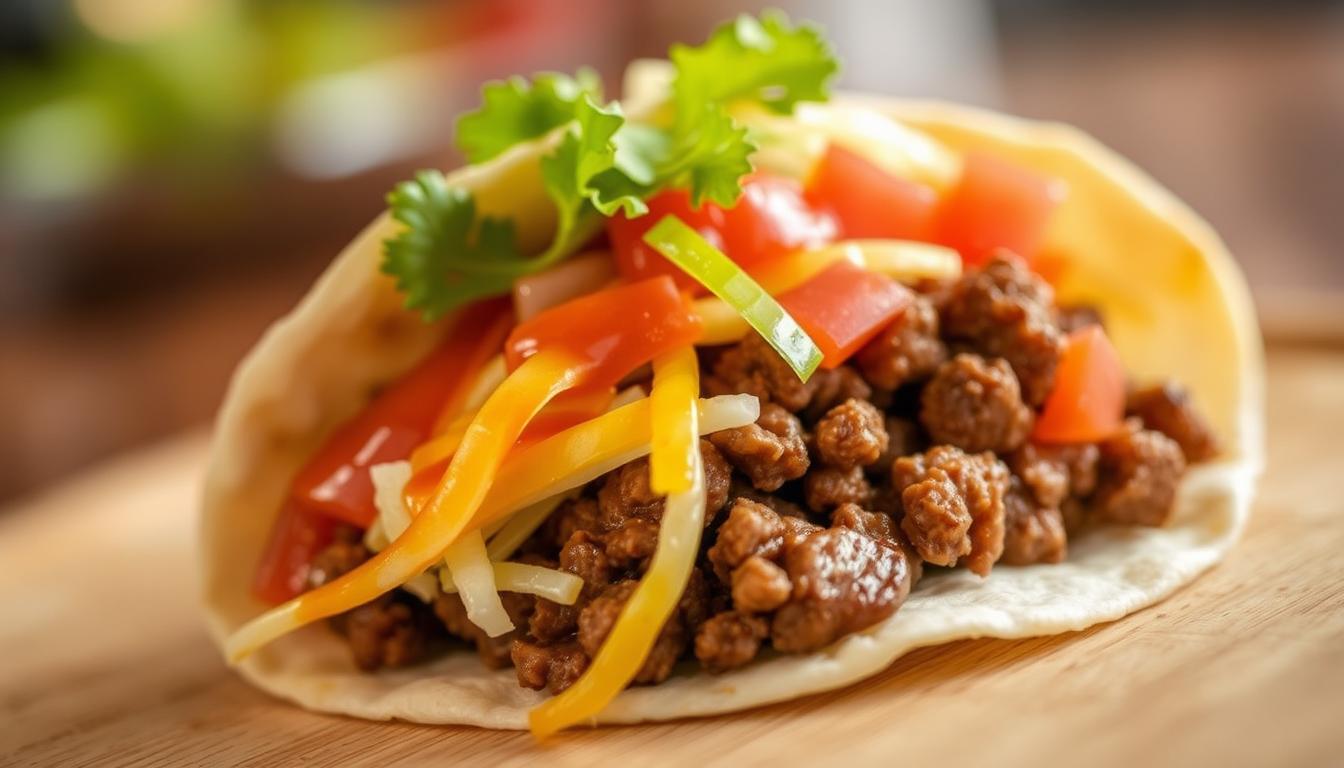Are you ready to elevate your weeknight meals with a dish that combines the heartiness of Japanese cuisine? Look no further than beef curry udon, a comforting and flavorful noodle soup that has captured the hearts of many food lovers.
Imagine thick, chewy udon noodles smothered in a rich, mildly sweet Japanese curry sauce, topped with tender slices of beef. This dish is more than just a meal—it’s a celebration of comfort and tradition. Originating from Japan, beef curry udon has become a staple in many households, offering a perfect blend of convenience and taste.
What makes this recipe truly special is its simplicity. With a total preparation time of just 50 minutes, you can enjoy a satisfying bowl of beef curry udon even on your busiest days. The recipe is designed to be adaptable, allowing you to customize it to your taste preferences while maintaining its authentic flavors.
Key Takeaways
- Beef curry udon is an easy and flavorful dish perfect for weeknight meals.
- The recipe combines hearty udon noodles with a rich, mildly sweet Japanese curry sauce.
- Preparation time is just 50 minutes, making it ideal for busy schedules.
- The dish is customizable to suit various taste preferences.
- It offers a balance of comfort food and traditional Japanese cooking methods.
Introduction to Japanese Curry Udon
Discover the delightful world of Japanese curry udon, a dish that has won the hearts of many with its rich flavors and comforting warmth. Originating in Japan, this beloved dish combines the deep flavors of Japanese curry with the hearty texture of udon noodles, creating a culinary experience that feels like home.
History & Cultural Significance
Japanese curry udon has a fascinating history that dates back to the late 1800s when curry was first introduced to Japan. Over time, it evolved into a unique dish that blends Japanese traditions with foreign influences. Today, it stands as a testament to Japan’s culinary adaptability and creativity.
The dish is deeply rooted in Japanese culture, serving as a comfort food that transcends regional boundaries. Whether in bustling cities or quiet rural areas, curry udon is cherished for its ability to provide warmth and satisfaction to people of all ages.
Essential Flavor Components
At the heart of curry udon lies the perfect harmony of two key elements: Japanese curry and dashi. Japanese curry, with its mild sweetness and rich flavor, forms the foundation of the dish. Dashi, a traditional Japanese soup stock, adds depth and complexity, making it an indispensable component.
The choice of udon noodles is what sets this dish apart from other noodle-based meals. Thicker and chewier than regular noodles, udon noodles hold onto the flavorful curry sauce beautifully, creating a delightful texture in every bite.
Traditional Ingredients and Preparation
Traditional curry udon often features onions sautéed in a pot, which meld seamlessly with the dashi and udon noodles. This classic combination creates a dish that is both hearty and flavorful, embodying the essence of Japanese comfort food.
| Component | Traditional | Modern |
|---|---|---|
| Curry Base | Homemade curry roux with butter and flour | Store-bought curry roux for convenience |
| Noodles | Fresh, handmade udon | Frozen or dried udon for easy preparation |
| Broth | Dashi made from katsuobushi and kombu | Instant dashi packets for quicker cooking |
While traditional methods are still cherished, modern adaptations have made curry udon more accessible. This blend of old and new ensures that the dish remains relevant, appealing to both purists and those seeking convenience without compromising on flavor.
https://www.youtube.com/watch?v=UuOI5uT00T4
Curry udon’s enduring appeal lies in its ability to comfort and satisfy. Whether enjoyed in a cozy home setting or at a bustling restaurant, it remains a beloved dish that continues to capture hearts. This section has provided a glimpse into its rich history and cultural significance, setting the stage for exploring its modern adaptations and the simple steps to create it at home.
Essential Ingredients for Beef Curry Udon
Creating an authentic beef curry udon begins with selecting the right ingredients. Each component plays a vital role in shaping the dish’s flavor and texture.
Japanese Curry Roux and Dashi
The foundation of a great curry udon lies in its curry roux. Japanese curry roux is essential for developing a deep, rich flavor profile. While traditional recipes use homemade roux made from butter and flour, store-bought options offer convenience without compromising taste. Pair this with dashi, a traditional Japanese soup stock, to add umami and complexity. Dashi can be made from scratch using katsuobushi and kombu or simplified with instant dashi powder.
Beef and Udon Noodles
Selecting the right beef and noodles is crucial. Opt for premium beef slices, such as shabu-shabu beef, for tenderness. Udon noodles should be thick and chewy to hold the curry sauce perfectly. Fresh noodles are ideal, but frozen or dried varieties work well too. A small amount of fat, whether from beef or oil, enhances the sauce’s mouthfeel and richness.
| Ingredient | Traditional | Modern |
|---|---|---|
| Curry Roux | Homemade with butter and flour | Store-bought roux for convenience |
| Beef | Thinly sliced premium cuts | Shabu-shabu beef for quick cooking |
| Noodles | Fresh, handmade udon | Frozen or dried udon for ease |
For healthier options, consider leaner beef or reduce oil. These adjustments maintain flavor while catering to dietary needs.
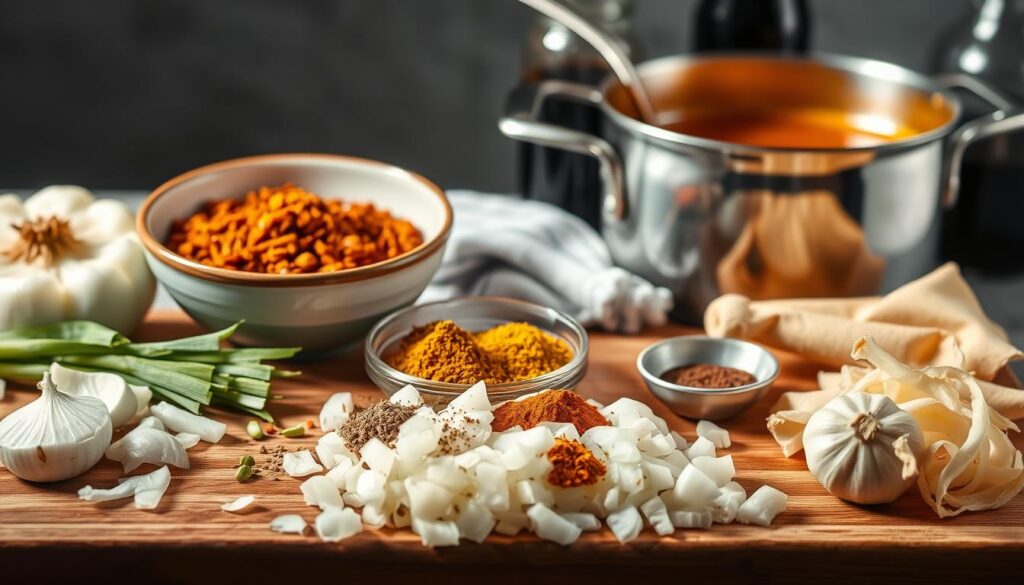
Unveiling the Top 5 Beef Curry Udon Recipe
Discover the best beef curry udon recipes that stand out for their unique flavors and simplicity. These dishes are perfect for anyone looking to enjoy an authentic Japanese meal at home.
Why These Recipes Stand Out
Each recipe offers something special, from the use of premium brands to the convenience of frozen udon. Here’s what makes them exceptional:
1. Chewy Texture and Flavor Balance: The thick, chewy udon noodles perfectly hold onto the rich curry sauce, creating a delightful texture in every bite. Small pieces of tender beef add to the overall dining experience.
2. Convenience Meets Tradition: Using frozen udon saves time without sacrificing quality. Pair it with store-bought curry roux for a quick yet flavorful meal that stays true to traditional methods.
3. Brand-Specific Enhancements: Premium brands like Sapporo Ichiban or Kikkoman elevate the dish with consistent quality. These ingredients ensure a rich, authentic taste that home cooks and restaurant chefs alike appreciate.
4. Unique Touches: Some recipes incorporate additional ingredients like soy sauce or mirin for depth, while others focus on quick cooking techniques to make the dish accessible to everyone.
5. Customization Options: Whether you prefer a leaner version or extra garnishes, these recipes allow for personal touches, making them versatile for different tastes and dietary needs.
These top recipes showcase the versatility of beef curry udon, blending tradition with modern convenience. They’re perfect for anyone looking to create a delicious, satisfying meal without spending hours in the kitchen.
Step-by-Step Guide to Making Curry Udon
Mastering the art of curry udon is simpler than you think. Follow these easy steps to create a delicious, authentic dish at home.
Preparing the Curry Base
To start, heat 1-2 tablespoons of oil in a large pot over medium heat. Add sliced onions and sauté for about 3-4 minutes until translucent. Then, add your beef and cook for another 3-5 minutes until browned, ensuring optimal flavor extraction.
Next, add 2 ½ cups of dashi stock to the pot and bring it to a boil. Stir in the Japanese curry roux, breaking it up with a spatula to avoid lumps. Reduce the heat to a simmer and let the curry base cook for 10-15 minutes, stirring occasionally, until it thickens into a velvety texture.
Cooking the Udon Noodles
Cook your udon noodles separately according to package instructions. For frozen udon, boil them in salted water for 2-3 minutes, then drain and rinse lightly. Fresh noodles typically take 1-2 minutes less. Handle them gently to preserve their chewy texture.
Once the noodles are ready, place them in a bowl and pour the hot curry sauce over them. Serve immediately for the best experience.
| Component | Traditional Method | Modern Method |
|---|---|---|
| Curry Roux | Melted butter and flour | Store-bought roux |
| Cooking Time | Longer simmering | Quick cooking |
| Noodles | Fresh, handmade | Frozen or dried |
By following these steps, you can enjoy a perfectly balanced curry udon with minimal effort. The key is to control the heat and stir gently to achieve the ideal consistency.
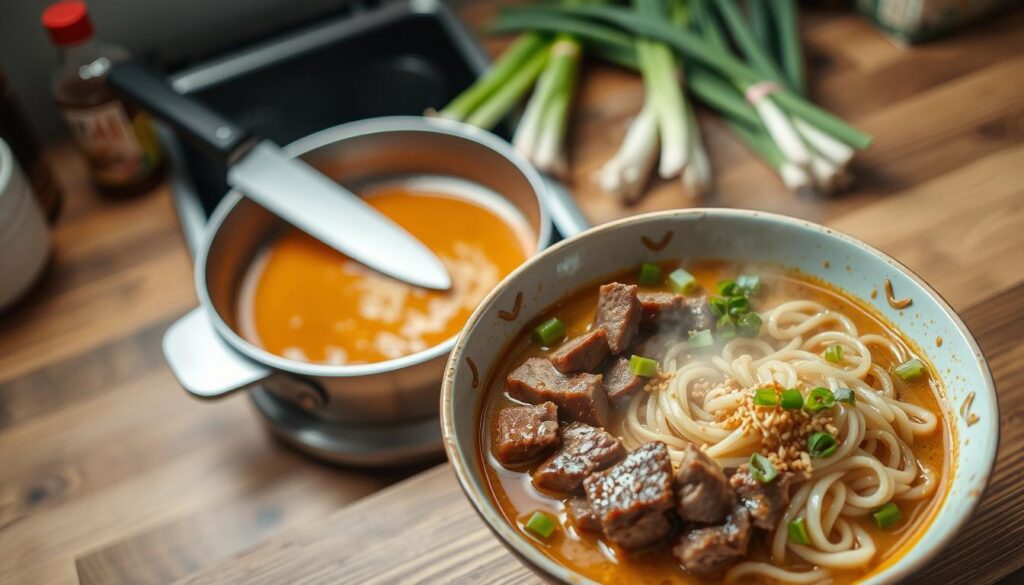
Tips for Perfecting Your Curry Udon
Elevate your curry udon game with these expert tips! Mastering this dish is all about finding the right balance of flavors and textures while allowing for creativity in the kitchen.
Ingredient Substitutions and Adjustments
Curry udon is incredibly versatile, and with a few tweaks, you can tailor it to your taste preferences. Here are some expert tips to help you perfect your dish:
- Seasoning with Soy Sauce: A dash of soy sauce can beautifully balance the sweet and savory notes in your curry. Start with a small amount and taste as you go to avoid over-seasoning.
- Protein Variations: While beef is a classic choice, you can also use chicken or pork for a different flavor profile. For a vegetarian option, mushrooms add a hearty, earthy touch.
- Enhancing Homemade Curry: To deepen the flavor of your homemade curry, try adding a pinch of cumin or a sprinkle of paprika. These subtle additions can elevate the dish without overpowering it.
- Tasting and Adjusting: Always taste your curry at each step. This simple habit ensures your dish is perfectly balanced and allows for real-time adjustments.
“Curry udon is a canvas waiting for your personal touch. Whether you’re a meat lover or a vegetarian, the right substitutions can transform this dish into something truly special.”
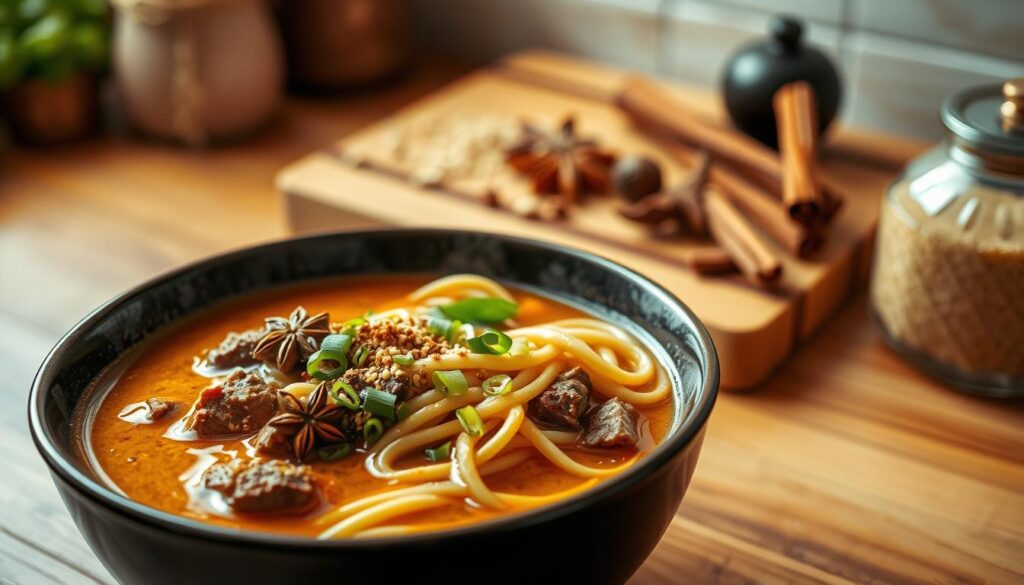
By experimenting with these tips, you’ll find the perfect harmony of flavors and textures that make your curry udon a standout dish every time. Remember, the key to a great meal is in the details and the joy of creation!
Flavor Enhancements and Garnish Ideas
Enhancing the flavor and presentation of your curry udon can elevate it from a simple meal to a culinary masterpiece. With a few creative touches, you can add depth, texture, and visual appeal to this beloved dish.
Incorporating Soy Sauce and Mirin
A dash of soy sauce can beautifully balance the sweet and savory notes in your curry. Start with a small amount and taste as you go to avoid over-seasoning. For added brightness, a drizzle of mirin can enhance the dish’s complexity, creating a harmonious balance of flavors.
Creative Toppings for Added Texture
Finely sliced green onions, crispy garlic, and toasted sesame seeds are just a few garnishes that add contrasting textures. These elements not only improve the visual appeal but also heighten the flavor profile of your curry udon.
For those who enjoy a bit of heat, a light sprinkle of pepper can add an extra layer of spice. This simple addition allows you to customize the dish to your desired level of spiciness.
Serving the dish immediately while hot is crucial. This ensures the optimal texture and flavor of both the noodles and the sauce are preserved. The combination of chewy udon noodles and a steaming hot curry sauce creates a truly satisfying experience.
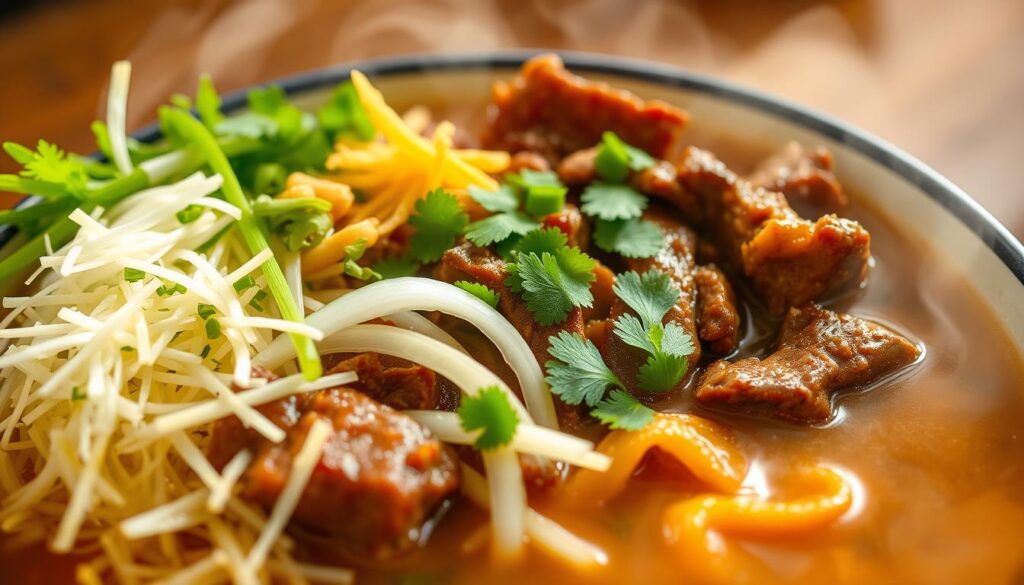
By experimenting with these creative garnishes and flavor enhancers, you can transform your curry udon into a dish that delights both the eyes and the palate. Whether you’re a fan of bold flavors or subtle touches, there’s a way to make this meal uniquely yours.
Variations for Customizing Your Udon Dish
Customizing your udon dish allows you to explore a world of flavors and textures, making each bowl uniquely yours. Whether you’re a meat lover or prefer a plant-based option, there’s a way to tailor this dish to your taste.
Meat and Meatless Options
Traditional beef-based udon is a classic choice, offering rich, savory flavors. However, you can also experiment with other proteins like pork or chicken for a different twist. For a meatless version, mushrooms, especially shiitake, add an earthy, hearty texture that’s just as satisfying.
Customization Tips:
- Use curry powder to adjust the intensity of the sauce, adding depth without overpowering the dish.
- Save time by using store-bought curry roux and pre-cut vegetables, making the recipe quicker without sacrificing flavor.
- For visual guidance, refer to video tutorials that demonstrate various preparation techniques and adaptations.
Serving your udon in a well-prepared bowl enhances both presentation and enjoyment. Arrange the noodles and toppings artfully to create a vibrant, appealing dish that’s as pleasing to the eyes as it is to the palate.
Culinary Techniques and Time-Saving Methods
Mastering the art of cooking doesn’t have to mean spending hours in the kitchen. With the right techniques and a little planning, you can create delicious meals efficiently. This section shares practical tips to help you streamline your cooking process and maintain a tidy kitchen.
Efficient Prep Techniques
Efficient ingredient preparation is key to a smooth cooking experience. Start by prepping your ingredients in measured cups to ensure accuracy. For instance, measuring liquids in cups helps maintain the right balance in your dish. This approach is especially useful when working with proteins like shiitake mushrooms, which add both texture and flavor.
Using pre-prepped proteins and mushrooms can save valuable time. Opt for sliced shiitake mushrooms and pre-cut proteins to minimize chopping time. This not only speeds up your prep but also reduces kitchen mess. Incorporating soy-based ingredients like soy sauce can enhance umami without extra effort, adding depth to your dish.
Quick Clean-Up Tips
Maintaining a clean kitchen while cooking can be straightforward. Clean as you go by washing utensils and containers immediately after use. This habit prevents clutter and makes post-cooking clean-up easier. Additionally, using disposable liners for pans can simplify the cleaning process, especially when dealing with sticky sauces.
Organizing your workspace is another effective strategy. Keep frequently used items within easy reach to avoid unnecessary movements. After cooking, soak any stubborn stains in pans to make scrubbing easier later. These small steps can make a big difference in maintaining an orderly kitchen.
By implementing these efficient techniques and clean-up hacks, you can enjoy a more organized and stress-free cooking experience. Whether you’re a seasoned cook or just starting out, these tips will help you create delicious meals while keeping your kitchen tidy.
Conclusion
With its blend of rich flavors and hearty textures, beef curry udon offers a delightful culinary experience that’s both easy to make and satisfying to eat. This dish is perfect for weeknight meals, combining tender beef, chewy udon noodles, and a flavorful curry sauce that’s sure to please everyone.
One of the best things about this dish is its simplicity. With just a few ingredients like store-bought curry roux and pre-cut beef, you can create a delicious meal in no time. Simply sauté the onions and beef, add the curry roux and dashi, and let it simmer until the sauce thickens. Cook the udon noodles separately and combine everything for a quick and tasty meal.
For those who like to plan ahead, leftovers can be stored in an airtight container in the fridge for up to 3-4 days. If you prefer a longer storage option, the curry can be frozen for up to 3 months. Just thaw and reheat it when you’re ready for another delicious meal.
Feel free to experiment with the recipe by adjusting the amount of curry roux to your taste. Start with a small amount, like 1-2 tablespoons, and add more if desired. This flexibility makes the dish customizable to suit any palate.
Don’t hesitate to give this recipe a try and make it your own. Whether you’re a seasoned cook or a kitchen newbie, beef curry udon is a dish that’s easy to love. Share your creations and enjoy the journey of culinary exploration!


